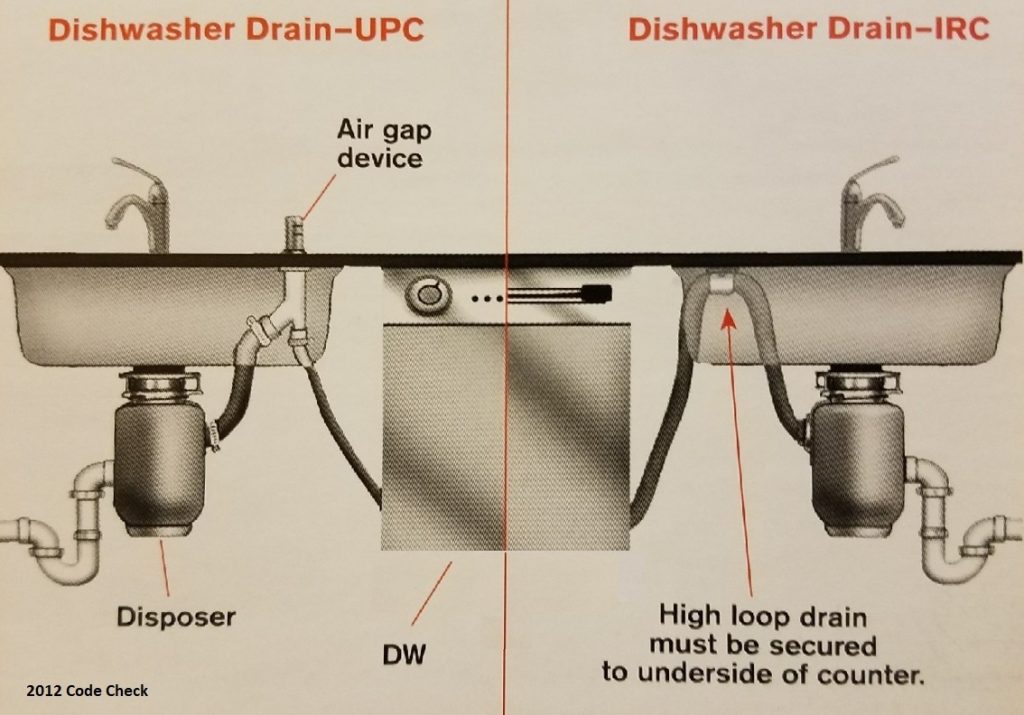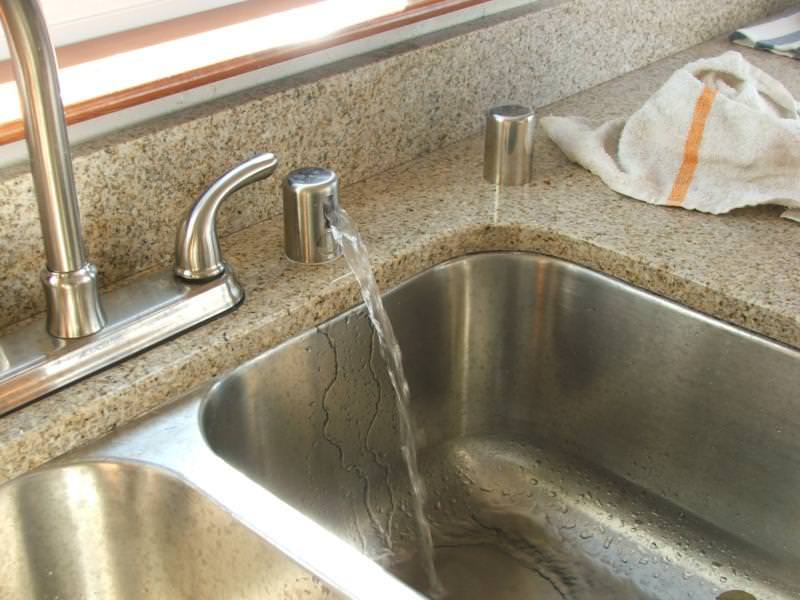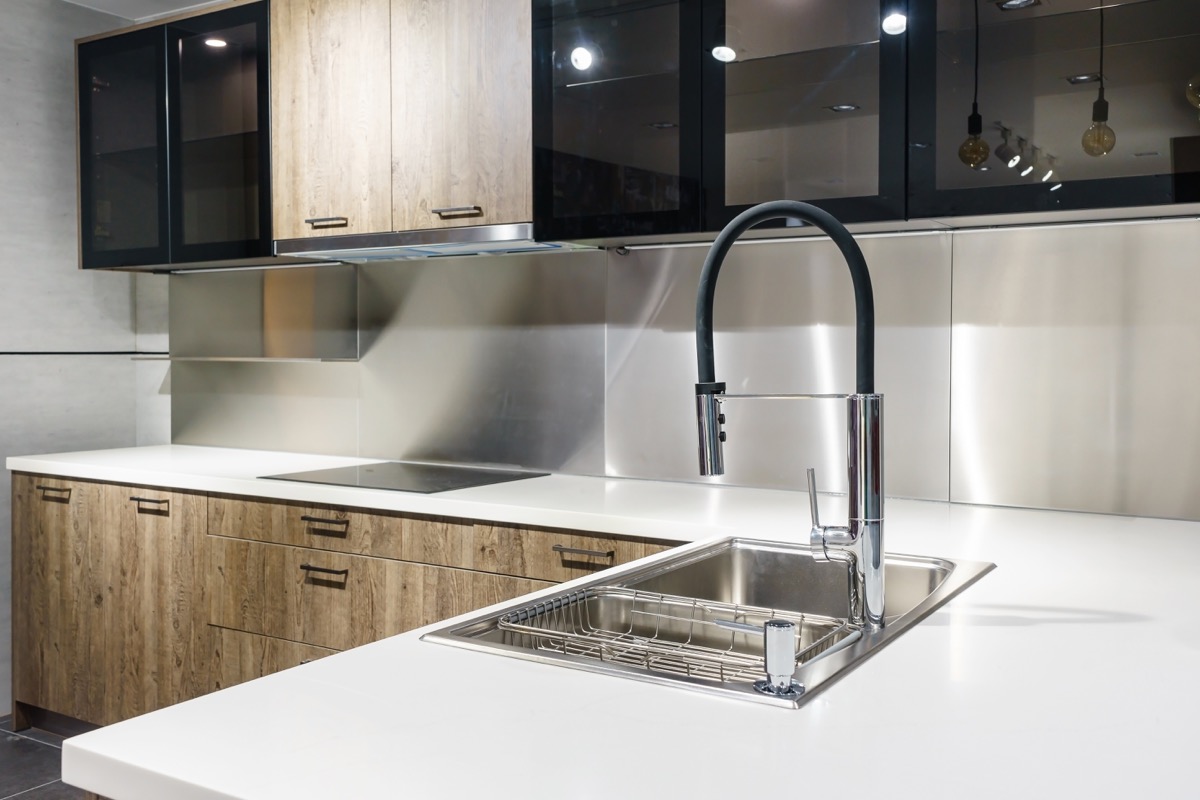An air gap on a vertical kitchen sink drain is a small device that is installed to prevent contamination of the water supply. It is typically located on the sink's countertop or behind the sink and is designed to create a physical separation between the dishwasher or garbage disposal unit and the kitchen sink drain. The purpose of an air gap is to prevent any waste or dirty water from flowing back into the clean water supply, which can happen if there is a blockage or malfunction in the plumbing system. It is an essential safety feature that is required by building codes in many areas.What is an Air Gap on a Vertical Kitchen Sink Drain?
Installing an air gap on a vertical kitchen sink drain is a relatively simple process that can be completed by most homeowners. However, it is important to follow the instructions carefully and have the necessary tools and materials on hand before beginning the installation. First, you will need to purchase an air gap device from a hardware or home improvement store. Next, you will need to shut off the water supply to the sink and disconnect the drain line from the garbage disposal or dishwasher. Then, using a drill and a hole saw, create a hole in the countertop or sink for the air gap to fit into. Once the hole is created, insert the air gap and secure it in place using the provided mounting hardware. Finally, reconnect the drain line and turn the water supply back on. It is recommended to test the air gap by running water through the sink and checking for any leaks.How to Install an Air Gap on a Vertical Kitchen Sink Drain
An air gap on a vertical kitchen sink drain is an essential safety feature that is required by building codes in many areas. It serves as a physical barrier between the water supply and any potential contaminants that may enter the drain line. Without an air gap, dirty water or waste from the sink or dishwasher could potentially flow back into the clean water supply, posing a health hazard. Additionally, an air gap helps to prevent any potential clogs or blockages in the plumbing system, which could lead to costly repairs. It is a small investment that provides significant benefits and peace of mind.Why Do I Need an Air Gap on My Vertical Kitchen Sink Drain?
If you are experiencing issues with your air gap, there are a few troubleshooting steps you can take before calling a professional plumber. First, check for any visible blockages or obstructions in the air gap or drain line. If there is a blockage, it can usually be cleared using a small brush or pipe cleaner. If there are no visible blockages, try cleaning the air gap by removing it from the countertop or sink and soaking it in a mixture of hot water and vinegar. This will help to remove any build-up or debris that may be causing the issue. If these steps do not resolve the problem, it is best to call a plumber for further assistance.How to Troubleshoot an Air Gap on a Vertical Kitchen Sink Drain
The primary benefit of an air gap on a vertical kitchen sink drain is maintaining the safety and purity of the water supply. It provides a physical barrier between the clean water and potential contaminants, ensuring that the water remains safe for consumption. Additionally, an air gap helps to prevent any potential clogs or blockages in the plumbing system, which can save homeowners from costly repairs. Another benefit of an air gap is that it is relatively easy to install and maintain, making it a convenient addition to any kitchen sink. It also adds value to the home and can be a selling point for potential buyers.What Are the Benefits of an Air Gap on a Vertical Kitchen Sink Drain?
Regularly cleaning the air gap on a vertical kitchen sink drain is essential to maintain its effectiveness and prevent any potential issues. To clean the air gap, first, remove it from the countertop or sink and disassemble it by removing the cap and the internal components. Soak the components in a mixture of hot water and vinegar for at least 30 minutes to loosen any build-up or debris. Then, use a small brush or pipe cleaner to remove any remaining residue. Rinse the components thoroughly and reassemble the air gap before returning it to its original location.How to Clean an Air Gap on a Vertical Kitchen Sink Drain
There are several different types of air gaps available for vertical kitchen sink drains. The most common types include traditional air gaps, decorative air gaps, and high-flow air gaps. Traditional air gaps are the most basic and affordable option, and they consist of a small device that is mounted on the sink or countertop. Decorative air gaps offer a more aesthetically pleasing option, with various designs and finishes available to match the kitchen's décor. High-flow air gaps are designed for use with high-powered garbage disposals and dishwashers and offer a larger opening to accommodate the increased water flow.What Are the Different Types of Air Gaps for Vertical Kitchen Sink Drains?
If your air gap is damaged or no longer functioning correctly, it may need to be replaced. The process of replacing an air gap is similar to the installation process, but it may require the use of a few additional tools. First, shut off the water supply to the sink and disconnect the drain line from the garbage disposal or dishwasher. Then, remove the old air gap by unscrewing it or cutting it out using a saw. Next, follow the steps for installing a new air gap, and remember to test for leaks before reconnecting the drain line and turning the water supply back on.How to Replace an Air Gap on a Vertical Kitchen Sink Drain
Building codes for installing an air gap on a vertical kitchen sink drain may vary depending on your location. However, most codes require that the air gap be installed within six inches of the sink or countertop and that it is mounted at least one inch above the sink's flood level rim. It is essential to check with your local building department before installing an air gap to ensure you are following the correct codes and regulations.What Are the Building Codes for Installing an Air Gap on a Vertical Kitchen Sink Drain?
To maintain an air gap on a vertical kitchen sink drain, it is essential to regularly clean it, as mentioned earlier. Additionally, it is crucial to check for any visible signs of damage or wear and tear, such as cracks or leaks. If you notice any issues, it is best to address them promptly to prevent any potential problems. It is also recommended to have a professional plumber inspect the air gap and the rest of your plumbing system annually to ensure everything is functioning correctly and to catch any potential issues before they become major problems.How to Maintain an Air Gap on a Vertical Kitchen Sink Drain
The Importance of an Air Gap on a Vertical Kitchen Sink Drain

What is an Air Gap?
 An air gap is a small, physical gap between the bottom of a kitchen sink and the top of the drain pipe. This gap allows air to flow in and out of the drain, preventing any unwanted backflow or siphoning of dirty water into the sink. In simpler terms, it acts as a barrier between the sink and the sewer system, ensuring that the water and waste from your sink are properly disposed of.
An air gap is a small, physical gap between the bottom of a kitchen sink and the top of the drain pipe. This gap allows air to flow in and out of the drain, preventing any unwanted backflow or siphoning of dirty water into the sink. In simpler terms, it acts as a barrier between the sink and the sewer system, ensuring that the water and waste from your sink are properly disposed of.
The Purpose of an Air Gap
 The main purpose of an air gap is to prevent contaminated water from flowing back into your sink. This is especially important in the kitchen, where food particles and grease can easily clog up the pipes and create a breeding ground for bacteria. Without an air gap, there is a risk of cross-contamination between your sink and the sewer system, which can be hazardous to your health.
The main purpose of an air gap is to prevent contaminated water from flowing back into your sink. This is especially important in the kitchen, where food particles and grease can easily clog up the pipes and create a breeding ground for bacteria. Without an air gap, there is a risk of cross-contamination between your sink and the sewer system, which can be hazardous to your health.
The Importance of an Air Gap on a Vertical Kitchen Sink Drain
 While an air gap is important for all types of sink drains, it is particularly crucial for vertical kitchen sink drains. This is because vertical drains have a shorter distance between the sink and the sewer system, making it easier for water to flow back up. Without an air gap, there is a higher chance of clogs and contamination, which can lead to costly repairs and health issues.
While an air gap is important for all types of sink drains, it is particularly crucial for vertical kitchen sink drains. This is because vertical drains have a shorter distance between the sink and the sewer system, making it easier for water to flow back up. Without an air gap, there is a higher chance of clogs and contamination, which can lead to costly repairs and health issues.
The Benefits of an Air Gap
 Aside from preventing backflow and contamination, an air gap also has other benefits. It helps to reduce the noise and vibrations from the sink, making it a more peaceful and comfortable kitchen experience. It also allows for better drainage, as air can easily escape through the gap, allowing water to flow freely down the drain.
Aside from preventing backflow and contamination, an air gap also has other benefits. It helps to reduce the noise and vibrations from the sink, making it a more peaceful and comfortable kitchen experience. It also allows for better drainage, as air can easily escape through the gap, allowing water to flow freely down the drain.
How to Ensure Your Kitchen Sink has an Air Gap
 When designing your kitchen, it is important to make sure that your sink has an air gap. This can be achieved by installing an air gap device, which can be found at most hardware stores or online. It is also important to regularly check and clean your air gap to ensure that it is functioning properly. If you notice any issues or irregularities, it is best to consult a professional plumber.
When designing your kitchen, it is important to make sure that your sink has an air gap. This can be achieved by installing an air gap device, which can be found at most hardware stores or online. It is also important to regularly check and clean your air gap to ensure that it is functioning properly. If you notice any issues or irregularities, it is best to consult a professional plumber.
In Conclusion
 In summary, having an air gap on your vertical kitchen sink drain is crucial for proper sanitation and drainage. It not only prevents backflow and contamination, but also has other benefits such as reducing noise and improving drainage. If you are designing your kitchen or experiencing any issues with your sink, be sure to prioritize the installation and maintenance of an air gap for a healthier and more efficient household.
In summary, having an air gap on your vertical kitchen sink drain is crucial for proper sanitation and drainage. It not only prevents backflow and contamination, but also has other benefits such as reducing noise and improving drainage. If you are designing your kitchen or experiencing any issues with your sink, be sure to prioritize the installation and maintenance of an air gap for a healthier and more efficient household.























































